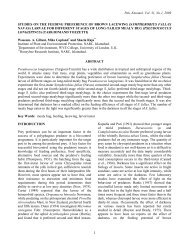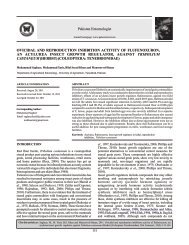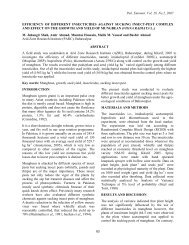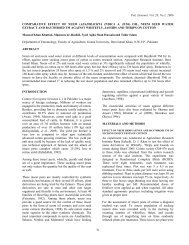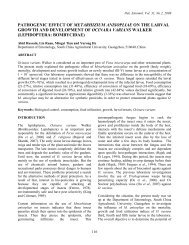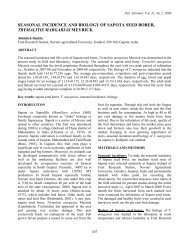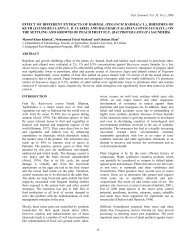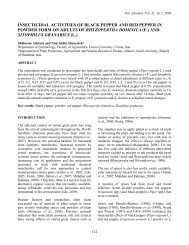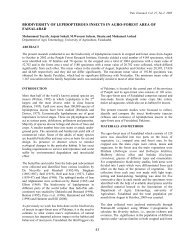Laboratory evaluation of chlorpyrifos, bifenthrin, imidacloprid ...
Laboratory evaluation of chlorpyrifos, bifenthrin, imidacloprid ...
Laboratory evaluation of chlorpyrifos, bifenthrin, imidacloprid ...
You also want an ePaper? Increase the reach of your titles
YUMPU automatically turns print PDFs into web optimized ePapers that Google loves.
Pak. Entomol. Vol. 28, No.2, 2006<br />
Table 3. LT 50 values (hrs) <strong>of</strong> different concentrations <strong>of</strong> flufenoxuron 10 DC for M. obesi in treated<br />
soil and in direct exposure<br />
Soil<br />
Concentrations Faisalabad Chakwal Layyah<br />
C 1 (1000 ppm) 2.51 3.62 2.85 1.32<br />
C 2 (500 ppm) 3.23 5.10 3.48 1.80<br />
C 3 (250 ppm) 4.73 7.26 4.45 2.37<br />
C 4 (125 ppm) 7 11 6.37 3.60<br />
C 5 (Control) 98 133 132 132<br />
Direct exposure<br />
DISCUSSION<br />
Chlorpyrifos 40 EC at 1000 ppm was found to be the<br />
most effective insecticide against M. obesi with LT 50<br />
ranging between 9 to 15 min in all the soils. The<br />
LT 50 increases with the decrease in concentration.<br />
Our results are in confirmation with the results <strong>of</strong> Su<br />
et al. (1987) who stated that mortality <strong>of</strong> termites<br />
exposed to <strong>chlorpyrifos</strong> 40 EC typically occurred<br />
within the first 24h <strong>of</strong> exposure. No penetration was<br />
observed in all the concentrations <strong>of</strong> <strong>chlorpyrifos</strong> 40<br />
EC. Su et al. (1995) reported that the termite species<br />
did not penetrate sand containing more > 100ppm <strong>of</strong><br />
<strong>chlorpyrifos</strong> 40 EC. Su and Scheffrahn (1990)<br />
reported that termite did not fully penetrate the<br />
treated sand at high concentration due to high<br />
mortality. Bifenthrin 10EC was not penetrated by<br />
Reticulitermes flavipes at any thickness through the<br />
sand treated with 1ppm (Hu, 2005). Imidcloprid<br />
50SL and thiamethoxam 70WS caused the mortality<br />
in M. obesi but their efficacy did not match with<br />
<strong>chlorpyrifos</strong> 40 EC and <strong>bifenthrin</strong> 10EC.<br />
Imidachloprid 50SL was more efficient than<br />
thiamethoxam 70WP and flufenoxuron 10DC. These<br />
results are in agreement to that <strong>of</strong> Almeida and<br />
Alves (1999) who reported that <strong>imidacloprid</strong> had<br />
better efficacy against termites. However, Remmen<br />
and Su (2005) reported that actara 70WS was found<br />
to be more toxic against C. formosanus and<br />
Reticulitermes flavipes. Cascade 10DC was found to<br />
be least effective for the control <strong>of</strong> termites,<br />
nevertheless, at high concentration no penetration<br />
was observed but at lower concentration the termite<br />
species penetrated into the soil.<br />
Topical application <strong>of</strong> the insecticides on the<br />
termites showed the following order <strong>of</strong> efficacy:<br />
<strong>chlorpyrifos</strong> > <strong>bifenthrin</strong> > flufenoxuron ><br />
thiamethoxam > <strong>imidacloprid</strong>.<br />
In nutshell, it is nearly difficult to achieve a<br />
homogenous concentration <strong>of</strong> these insecticides in<br />
the soil. It is unknown how these treatments may<br />
affect field population <strong>of</strong> termites. Future<br />
investigations include field studies to determine<br />
application <strong>of</strong> the insecticides per volume basis <strong>of</strong><br />
the soil.<br />
REFERENCES<br />
Ahmed, S., A. Naseer and S. Fiaz, 2005a.<br />
Comparative efficacy <strong>of</strong> botanicals and<br />
insecticides on termites in sugarcane at<br />
Faisalabad. Pak. Entomol., 27 (1): 23-26.<br />
Ahmed , S., M.A. Riaz and A. Hussain, 2005b.<br />
Comparative efficacy <strong>of</strong> Datura alba nees,<br />
Calotropis procera and <strong>imidacloprid</strong> on<br />
termites in sugarcane at Faisalabad. Pak.<br />
Entomol., 27 (2): 11-14.<br />
Akhtar, M.S. and A.S. Shahid, 1993. Termites as<br />
pest <strong>of</strong> agricultural crops in Pakistan. Pak. J.<br />
Zool., 25 (3): 187-193.<br />
Almeida, J.M. and S.B. Alves. 1999. Control <strong>of</strong> the<br />
subterranean termites Heterotermes tenuis<br />
(Hagen) (Isoptera: Rhinotermitidae) in<br />
sugarcane with termitrap ® baits associated<br />
with Beauveria bassiana (Bals) and<br />
insecticides in dry conditions. Arquivos-do-<br />
Instituto-siologico-sao-Pavlo, 66 (2): 85-90.<br />
Anonymous, 2001a. HDRA the organic<br />
organization: Ryton organic gardens<br />
Coventry CV8, 3LG, UK.<br />
Anonymous, 2001b. Chemical control <strong>of</strong><br />
Microtermes obesi and Odontotermes<br />
obesus (termites) in sugarcane. Ann. Rept.<br />
Ayub Agric. Res. Instt. Faisalabad, Pakistan.<br />
pp.39-40.<br />
48



